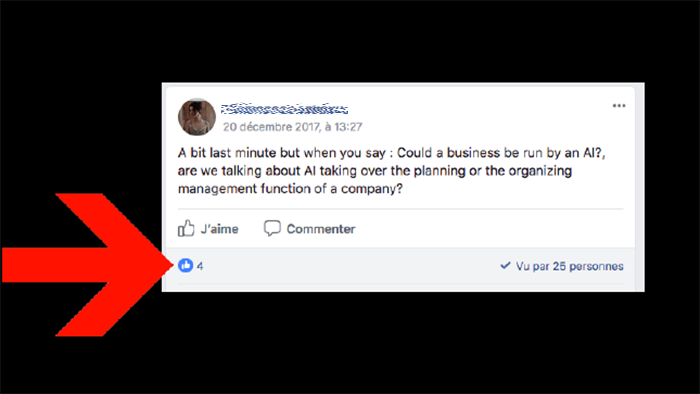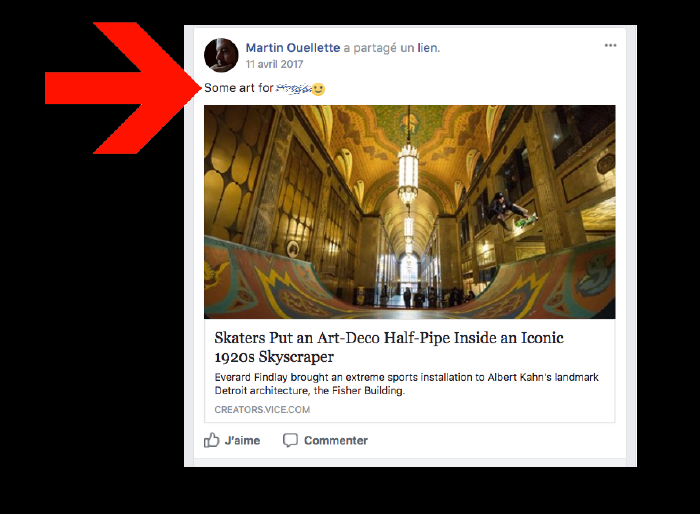I teach in the Art, Literature and Communications program at Collégial International Sainte-Anne. I use Facebook groups in my classes to make communicating and sharing information with my students easier. The use of that network also maintains a quality pedagogical relationship with my students.
As a teacher, I have a dream. I want to recreate this force in my classroom:

Starlings flight (murmuration). Scene from Jan van Ijken’s video The Art of Flying.
I like this idea that all individuals form a “whole” that escapes their individual goals, that they fly together. There is a kind of magic, a power and a lightness in the motion of that flock of birds. That is my personal aspiration. I want to recreate that in my class.
To produce that effect, 3 parameters must be fulfilled:
- Direction (going the same way as your peers)
- Cohesion (aiming for the heart of the group in motion)
- Separation (protecting your individual identity within the group)
I use Facebook because it offers all 3. Moreover, the students are already using it. My approach does not require them to learn to use a new tool and there is no need for me to act as technical support. I go and join them.
Direction
Each class that I teach has its own Facebook group. I use it to share information with my students. That way, I make sure that they all have access to the same information. This content might be this week’s homework, complementary content or the content provided in the previous class. The parameters of the group allow me to know who has seen the publication and make individual follow-ups through messaging or chat if needed.
Even when they miss a class, my students receive the important information. I can also tag them in a publication to bring their attention to a resource that I have shared.

Sharing of the diaporama of a class on Facebook. I tagged 2 students who were absent to bring their attention to clickable links integrated in the slides. At the same time, it allowed me to remind that fact to students who were there.
Facebook allows for live modifications, when a technical problem happens or I revise the instructions for an assignment; all the students are made aware instantly through a notification.
All the members of the group can publish on the page. The students may then react to a publication or answer each other. The more informal context allows the sharing of some complementary content such as:
- Explanation of concepts seen in class
- News related to the content of the class. Sometimes, students see a publication and share it in the group because it made them think of something they learned in class.
- Some specifications or last minute changes. I am thinking of a student who had prepared a presentation in a different room and had mentioned it in the group.

An example of a publication from a student in the Facebook group, reminding her classmates that her presentation will take place in a different room than the usual classroom.
I also use the Facebook group to share information about activities happening outside of school with the students. I sometimes publish suggestions of free activities connected to their field of study to allow them to be in contact with professionals.
Cohesion
The Facebook group allows to develop a feeling of belonging and of community. The fact that the group is closed allows for sparks of complicity between the students and me. A small common culture emerges – amongst ourselves, we understand each other. Then come the references and the parodies. I also share some pictures to tease my students.

A humorous image shared on the page of a class.
The Facebook group thus becomes a relationship-building tool. The ambiance is warm, human. I remember one time when the class had not gone too well. I explained the situation to my students through a publication, presenting them a video that I would have liked to show them in class. A former student commented on the importance of the video.
The Facebook group creates a new dynamic where the authority relationship disappears. That does not mean that I received less respect from the students. I do not feel shaken when a student tells a joke. I establish a limit if I consider that he goes too far, exactly as I would do in class.
On the group page, private questions become public and everyone benefits from the answers. Some students are afraid to ask a question but will “like” someone else asking the same question or adding some complementary information. The action is at once subtle and revealing. On my part, if a student asks me a question, I can share my clarifications with everyone, instead of answering to one person only or waiting for the next class.

The students can ask questions in the group. Those who are shy about contributing may share their approval otherwise, notably by “liking” or reacting to a publication.
Separation
Cohesion is important within the group, but the acknowledgement of the uniqueness of all individuals is just as important. Facebook also allows me to recognize the difference and the specificity of each student. I sometimes share content that fits their interests.

A publication that made me think of one of my students, a skateboarder, that I shared in a group associated to an art history class.
At the end of the semester, I recycled the concept of Vuk Vidor’s painting, Art History, that attributes the ownership of specific artistic contributions to artists that have made their mark that way. I attributed distinctive characteristics to each of my students.

A way to recognize the uniqueness of each student. I was inspired by Vuk Vidor’s painting Art History for this publication.
Content to improve myself
The Facebook group also allows me to get feedback on my teaching. At the end of the semester, I shared a survey asking students to evaluate the class. Another time, I was assigned 2 new classes. I found former students in my Facebook groups that enlightened me on what should be repeated or changed in the classes that I was planning.
The students’ perception
The students appreciate this use of Facebook a lot, for many different reasons. When I asked them about it, many answered that the group facilitated interactions with me, but also among themselves. Knowing that social network and using it every day makes it seem very useful to them.
Communication is made a lot easier. I even exchanged some office hours (where students rarely came to see me) for an increased availability online. The students seem to use this method to ask their questions a lot more.
The advantages of a Facebook group for teachers
- It is not necessary to be “friends” with the students for them to participate in the group.
- Students tend to participate more in the group and that is reflected in the class dynamic. They seem more involved.
- The pedagogic relationship is different, more transparent, and as rewarding. The group creates a proximity effect that encourages more frequent exchanges.
- There is no learning curve for the students. The time in class is not spent on learning to use a new tool.
Outside the box… and the time slot
The use of Facebook necessarily bursts open time slots. I accept to extend my availability beyond the “9 to 5” by committing to answering my students quickly (within some boundaries).
Quote “With their phones, the students virtually go ‘elsewhere’ when they are in class. I can thus reasonably hope that they ‘come to class’ when they are physically elsewhere.”
Concerning the moderation of the group, the students have shown me that they are perfectly able to regulate themselves. Typically, my students have an account for their family and an account for their friends. I am presented with my student’s “official” personality during the class.
If I had to define my role as a teacher, I would say it consists of enlightening students. I am in their lives only temporarily, so I wish to leave them more open-minded. I release the doubt. I present possibilities. I allow them to dream. And I have fun.

